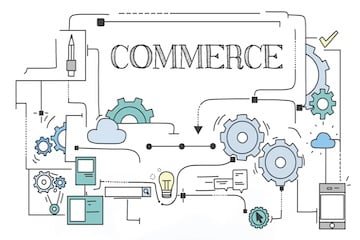In 2025, advances in composable commerce may enable even smaller ecommerce merchants to build tailored, flexible online shopping experiences that drive incremental revenue in competitive markets.
Composable commerce is an evolution of the more familiar headless commerce model.
Headless commerce decouples the frontend presentation layer from the backend code for faster updates and improved performance. Composable commerce takes it further, allowing the integration of best-of-breed tools and applications for a tailored, scalable, and, likely, more profitable ecommerce platform.

Composable commerce is the integration of best-of-breed tools and applications for a tailored and scalable platform.
Headless to Composable
For example, a headless commerce retailer might use an API to complete an ecommerce transaction in multiple channels, such as a website, app, social commerce system, or POS.
Composable commerce does the same and integrates a “packaged business capability” such as a best-in-class return management system or an influencer marketing platform.
“Headless is still growing and evolving,” wrote Allison “Al” Williams, general manager of business to consumer at BigCommerce, in an email to Practical Ecommerce. “What started as a very dev-centric ‘best practice’ primarily driven by front-end development teams…has now turned into a more holistic and modular approach…for managing overall ecommerce architecture (e.g., composable commerce).”
This trend toward modularity can benefit online merchants. Composable commerce is flexible, allowing businesses to adapt quickly to changing customer needs and market trends. Its modular design scales, making adding or removing components relatively easy, and encourages innovation by implementing technologies such as AI and low-code platforms.
Composable Commerce Benefits
Composable commerce is both compatible and an alternative to traditional, all-in-one ecommerce platforms such as BigCommerce and Shopify.
Combined, the benefits of headless and composable commerce produce dynamic and personal shopping experiences.
“With this evolution from headless to composable commerce, the merchant can pick and choose different applications to build a tech stack that best fits their business and their customers,” wrote BigCommerce’s Williams.
Flexibility allows users to custom-build a technology stack. Online shops that feel platform-constrained can use composable commerce to integrate microservices, APIs, cloud, headless, and Jamstack (JavaScript, APIs, and markup language).
The result could be faster mobile loads, new personalization methods, and data-driven product placement and pricing.
Adaptability of composable commerce ensures businesses can pivot as needs change. For example, a gourmet food retailer could launch subscription meal kits and use a customer data platform to offer recipes and ingredients tailored to each customer.
A modular stack means the business can add custom tools and capabilities regardless of its ecommerce or point-of-sale platform. Thus a change does not require overhauling or disrupting the entire system, enabling rapid time-to-market.
Scalability means composable commerce supports growth without breaking existing infrastructure.
For example, a regional home goods store might expand into international markets. By adding multilingual and multi-currency applications, the business meets the needs of new customers while maintaining its existing infrastructure.
Configurability facilitates customization. A shop can build experiences tailored to its brand and customers.
Imagine a fitness equipment retailer that integrates a virtual reality tool, allowing shoppers to visualize a home gym setup before purchasing. This versatility differentiates the retailer from competitors relying on more generic solutions.
Challenges
To date, most headless and composable commerce users are enterprise businesses and small shops with technical chops.
“A common challenge we hear is the perceived complexity of transitioning to a headless architecture, particularly managing multiple vendors and ensuring the seamless integration of components,” wrote Williams. “This complexity compounds based on the number of brands, geographies, and channels.”
Yet that is why 2025 might be a breakout year for composable commerce, especially for smaller businesses, judging from the number of companies building modular services. Practical Ecommerce has identified many composable commerce rollouts, including releases Commercetools, LTImindtree, PhaseZero, and Vtex.
All-in-one platforms apparently recognize the opportunity. Shopify, BigCommerce, and Salesforce offer composable storefronts and address the topic in guides and blog posts:




